Ijraset Journal For Research in Applied Science and Engineering Technology
- Home / Ijraset
- On This Page
- Abstract
- Introduction
- Conclusion
- References
- Copyright
Comparative Study of R.C.C. and Composite Structures Under Different Soil Conditions
Authors: Tushar Patidar, Dr. Savita Maru
DOI Link: https://doi.org/10.22214/ijraset.2024.58241
Certificate: View Certificate
Abstract
The need for multi-storey buildings arises from a fact that it offers vertical expansion, making them an ideal choice for maximizing available urban space without influencing valuable land resources. A thorough literature review has conducted for comparative study of RCC and Composite buildings and its various advancements conducted before. This paper is based on regular and irregular plan area under different soil conditions. Total 18 cases have taken for consideration (6- square shape, 6 – L shape and 6 – T shape plan) with 3 cases each of RCC and 3 cases for Composite building and method selected - Response Spectrum Method. Results for Square shape plan shows that SCPH case i.e. Square plan with Composite structure over hard soil performs well in most of the output parameters. Results for L shape plan shows that LCPH case i.e. L shape plan with Composite structure over hard soil performs well in most of the output parameters while in case of story displacement and drift LRCCH i.e. L shape plan with RCC structure over hard soil performs better but the values of LCPH are also within the limits of IS codes. Results for T shape plan shows that in case of story displacement and drift TRCCH i.e. T shape plan with RCC structure over hard soil performs better because of the higher stiffness of RCC structure while in all other output parameters TCPH i.e. T shape plan with composite structure over hard soil performs well. Concluding the research work, use of composite structure performs well and can be used with building stability techniques so that the displacement factors can be minimized for composite structures.
Introduction
I. INTRODUCTION
The demand for multistorey buildings generated from various factors with respect to urban populations growing rapidly, innovative solutions are needed to offer housing and commercial areas without consuming precious land. Multistorey structures address this by constructing it vertically. Additionally, economic factors come into play as land costs rise. Multistorey buildings provide cost-effective ways to optimize space, making them an attractive choice for developers and city planners.
A. RCC and Composite Structures
Both the Reinforced Concrete (RCC) and Composite building systems possess distinct qualities and benefits that align with the changing demands of urban infrastructure. This article examines the attributes and uses of both RCC and Composite buildings, offering valuable perspectives on how they each contribute to modern construction methodologies. RCC structures are architectural and engineering constructions that utilize reinforced concrete, combining the compressive strength of concrete and the tensile strength of steel reinforcement to create durable and load-bearing elements.
Here are some key features:
|
|
|
|
|
|
Composite structures are engineered systems that integrate different components, combining lightweight components with a matrix to achieve enhanced mechanical properties and functional advantages. Here are some aspects to consider:
|
|
|
|
|
|
II. RESEARCH OBJECTIVES
On keeping in mind the above problem statement outline for new research work is proposed in the form of conclusive outcomes given below :-
- To create and study various cases of different plan area over soft, medium and hard soil and comparing them by using Response Spectrum Method of dynamic analysis using ETABS software tool.
- To calculate modal participation factor for square shape, L shape and T shape plan area for both normal and composite structure.
- To determine and compare maximum displacement in X and Y direction for square shape, L shape and T shape plan area for both normal and composite structure.
- To evaluate and relate storey drift in X and Y direction for square shape, L shape and T shape plan area for both normal and composite structure.
- To determine maximum Overturning Moment for various cases.
- To study the variation in base shear in both X and Y direction.
- To compare different parametric values and mark the economic one in percent and at last, provide the recommendations and remedies for the uneconomic to create a feasible construction reference.
The main and foremost objective is to compare the conventional RCC framed building with advanced composite structure on regular and irregular plan areas on different soil conditions with comparison of various result parameters
III. PROCEDURE AND 3D MODELING OF THE STRUCTURE
Seismic analysis is carried out on a G+16 storey building by using a software approach. The seismic data is taken as per the IS 1893(PART1):2016. The response spectrum analysis method is adopted for analysis of buildings. Input details and model descriptions are mentioned below:-
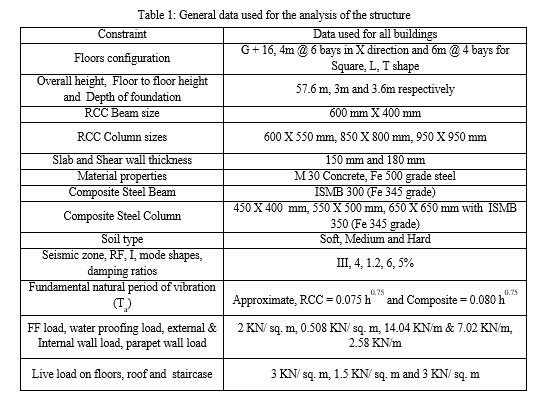
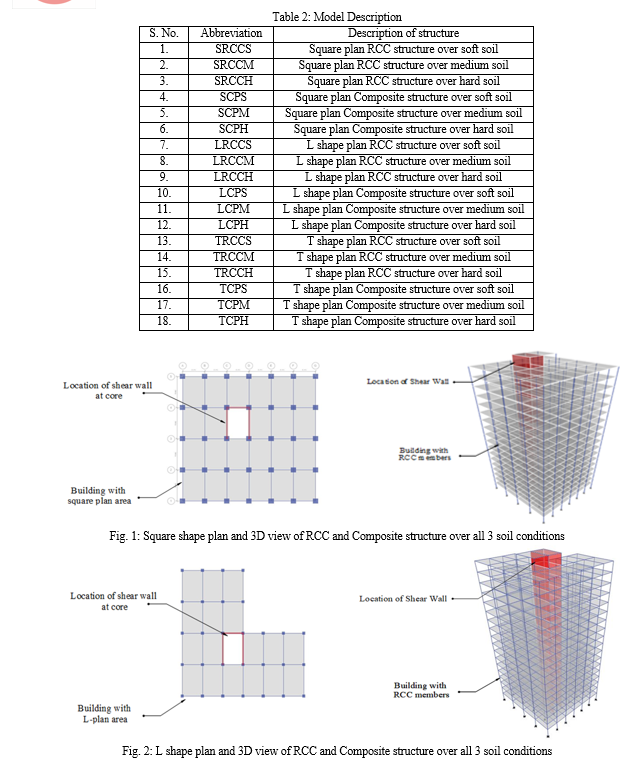
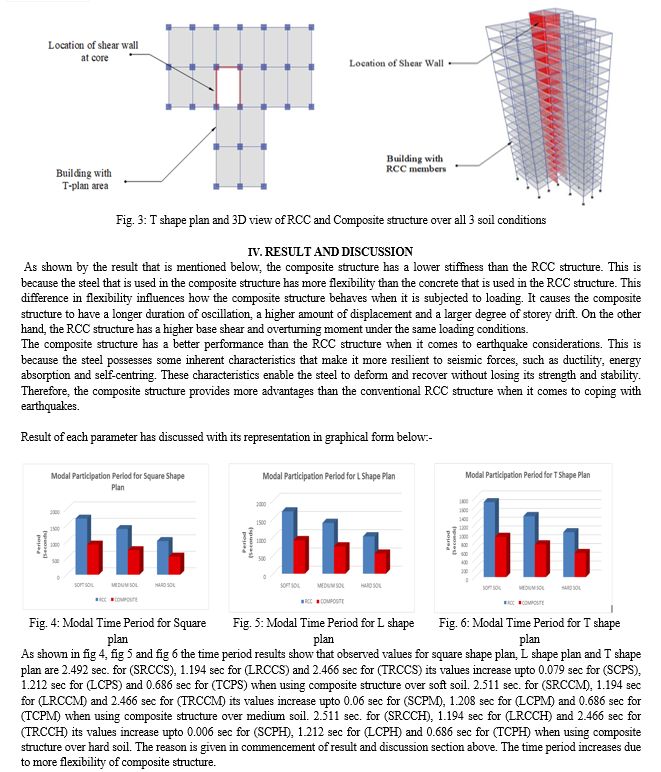
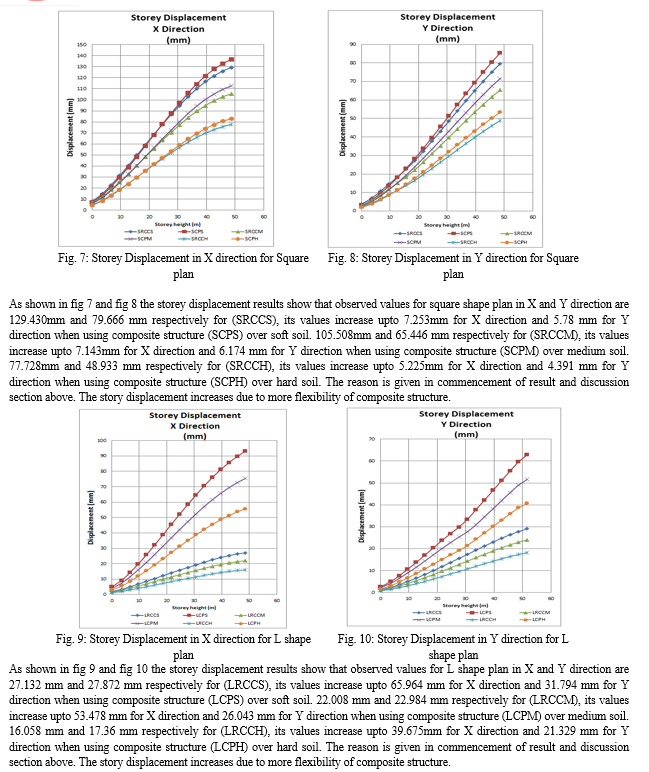
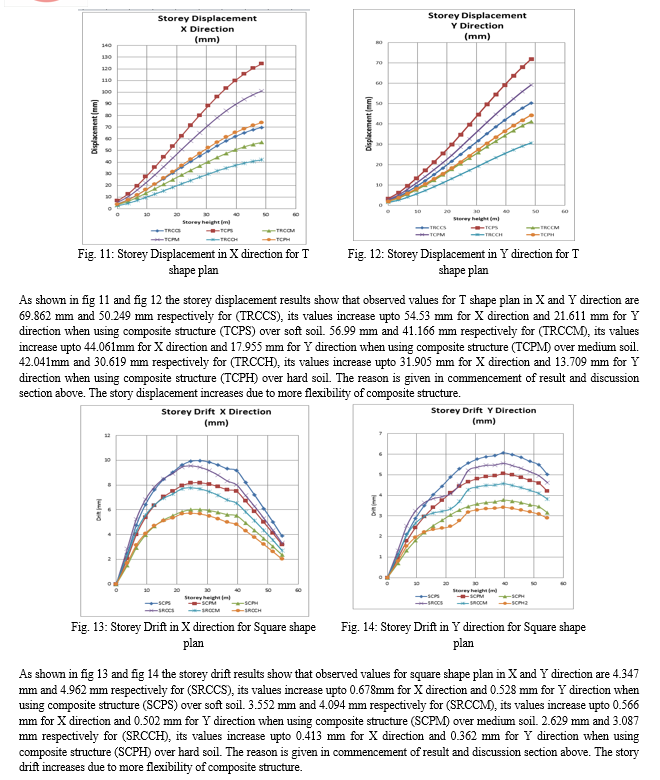

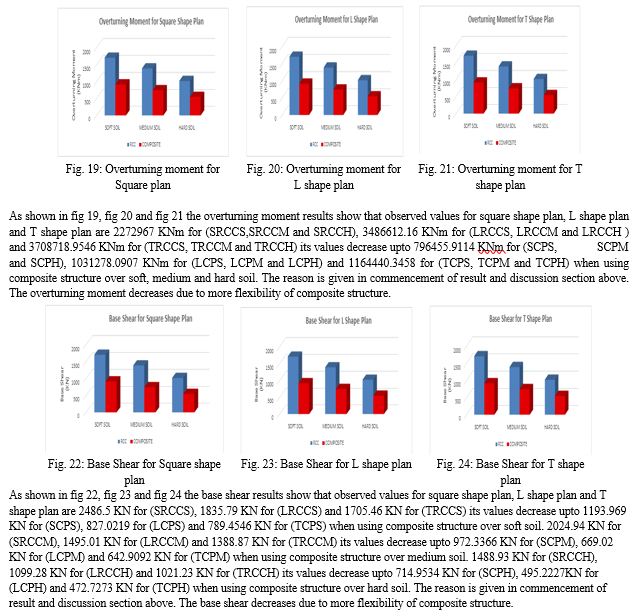
V. FUTURE SCOPE
- This project concluded that when using composite structure the parameters that affect building stability increases. This work can be further extended to usage of different types of composite materials.
- Different software’s can be used for further research for comparative analysis.
- This project can further be extended with analysis over actual soil conditions with geotechnical investigation report of an actual area.
- This work can be extended for different cities, so that the recommendations of the usage of light weight concrete can be predicted for the selected city.
- This project worked out on square shape, L shape and T shape plan area. The work can also be extended for different plan areas especially for vertical irregularities
VI. ACKNOWLEDGEMENTS
I, Tushar Patidar, M. Tech. Student, would like to thank Prof. Dr. Savita Maru, Professor, Department of Civil Engineering, Ujjain Engineering College, Ujjain, (M.P.), India for her valuable guidance from the commencement of the work up to the completion of the work along with her encouraging thoughts.
Conclusion
Based on the methodology adopted and analysis of various cases, the results have been evaluated and discussed thoroughly and have reached a conclusion that can be pointed out are as follows:- A. Conclusion for Square Shape Plan 1) On comparing all 6 model cases, the time period keeps on decreasing upto 82.30% from every mode shapes and observed minor difference in each case. 2) Displacement in X and Y direction shows decreasing values of 43.13% and 42.732% respectively and hence SCPH shows efficient case in square shape plan. 3) The storey drift values in X and Y directions shows minimum values in SCPH case with decreasing values of 62.671% and 43.575% respectively in square shaped plan. 4) When comparing the overturning moment for square shaped plan, the values trend keeps on decreasing with values upto 35.04 %, and observed least value in SPCS, SCPM and SCPH due to composite structures are lighter in weight and imposed less overturning moment than that of RCC structure. 5) The base shear values on comparing shows same values in both X and Y direction since plan area is symmetrical in both directions. The least values observed in SCPH i.e. composite structure on hard soil with decreasing values upto 68.873 %. B. Conclusion for L Shape Plan 1) On comparing all 6 model cases, the time period keeps on decreasing upto 74.28% from every mode shapes and observed least time period for RCC in medium and hard soil. 2) Displacement in X and Y direction shows decreasing values of 82.751% and 70.882 % respectively and hence LRCCH shows efficient case in L shape plan. 3) The storey drift values in X and Y directions shows minimum values in LRCCH case with decreasing values of 83.614% and 72.393% respectively in L shaped plan. 4) When comparing the overturning moment for L shaped plan, the values trend keeps on decreasing with values upto 29.57 %, and observed least value in LPCS, LCPM and LCPH due to composite structures are lighter in weight and imposed less overturning moment than that of RCC structure. 5) The base shear values on comparing shows same values in both X and Y direction since plan area is symmetrical in both directions. The least values observed in LCPH i.e. composite structure on hard soil with decreasing values upto 67.095%. C. Conclusion for T Shape Plan 1) On comparing all 6 model cases, the time period keeps on decreasing upto 81.123% from every mode shapes and observed least time period for RCC in medium and hard soil. 2) Displacement in X and Y direction shows decreasing values of 66.202% and 57.390 % respectively and hence TRCCH shows efficient case in T shape plan. 3) The storey drift values in X and Y directions shows minimum values in TRCCH case with decreasing values of 47.68% and 57.14% respectively in T shaped plan. 4) When comparing the overturning moment for L shaped plan, the values trend keeps on decreasing with values upto 31.39 %, and observed least value in TPCS, TCPM and TCPH due to composite structures are lighter in weight and imposed less overturning moment than that of RCC structure. 5) The base shear values on comparing shows same values in both X and Y direction since plan area is symmetrical in both directions. The least values observed in TCPH i.e. composite structure on hard soil with decreasing values upto 67.838 %. This project concluded that when comparing all the result parameters, in different plan areas, in case of story displacement and drift, SRCCH, LRCCH and TRCCH values shows lesser values since the stiffness of RCC members are more than composite structure. In all other output result parameters, composite values seems efficient values and hence should be recommended that when this type of construction procedure adopted, use of composite structure performs well and can be used with building stability techniques, the displacement factors can be minimized for composite structures.
References
[1] Anamika Tedia, Dr. Savita Maru, (2014), “Cost, Analysis and Design of Steel-Concrete Composite Structure Rcc Structure”, IOSR Journal of Mechanical and Civil Engineering (IOSR-JMCE), ISSN: 2278-1684, 11(1), pp. 54-59 [2] Ankit Kumar, Dr. Savita Maru, (2021), “Dynamic Analysis on RCC and Composite Structure for Uniform and Optimized Section”, International Journal for Research in Applied Science & Engineering Technology (IJRASET), ISSN: 2321-9653, Vol. 9, Issue 12, pp. 1114-1127. [3] Baoquan Cheng et. al. (2023), “Mechanical Properties of Full-Scale UHPC-Filled Steel Tube Composite Columns under Axial Load”, Materials, ISSN: 1996-1944, Vol. 16, paper no. 4860, pp. 1-19. [4] Ch Geetha Bhavani, Dr. Dumpa Venkateswarlu, (2016), “Comparative Seismic Analysis of RCC, Steel & Steel-Concrete Composite Frame”, International Journal of Research Sciences and Advanced Engineering (IJRSAE), ISSN: 2319-6106, Vol. 2, Issue 15, pp. 66-74. [5] D. R. Panchal and P. M. Marathe, (2011), “Comparative Study of R.C.C, Steel and Composite (G+30 Storey) Building”, International Conference on Current Trends in Technology, ‘NUiCONE – 2011, pp. 1-6. [6] Dr. Ramakrishna Hegde et. al. (2020), “Parametric Study Of Rcc, Steel And Composite Structures Under Seismic Loading”, International Research Journal of Engineering and Technology, ISSN: 2395-0056, 7(2), pp. 2658-2661. [7] Farid Boursas, et. al. (2023), “The Influence of Slenderness in Steel and Composite Columns under Fire Conditions”, Engineering, Technology & Applied Science Research, ISSN: 1792-8036, Vol. 13, Issue 1, pp. 10145-10150. [8] Gaurav Swami et. al. (2023), “Structural robustness of composite modular buildings: The roles of CFST columns and inter-module connections”, Journal of Structures, ISSN 2352-0124, Vol. 48, pp. 1491-1504 [9] John Cotter and Rasim Guldiken, (2023), “Bulk Glass Reinforced Composite Columns: Physical Testing Results, Analysis, and Discussion” Journal of Composites Science, ISSN: 2504-477X, Vol. 7, paper no. 241, pp. 1-20. [10] Karthiga et. al. (2020), “Comparison of seismic performance of reinforced concrete frame structure and composite frame structure using response spectrum analysis”, IOP Conf. Series: Materials Science and Engineering, Vol. 764, paper no. 012057, pp. 1-7. [11] Krunal P Suthar, Arjun M Butala, (2020), “Comparative Study on Seismic Analysis of (G+10) R.C.C, Steel and Steel-Concrete Composite Building”, International Research Journal of Engineering and Technology (IRJET), ISSN: 2395-0056, Vol. 07, Issue 05, pp. 662-666. [12] M Anbarasu et. al. (2023), “Numerical Parametric Study and Design of Pultruded GFRP Composite Channel Columns”, Sustainability, ISSN: 2071-1050, Vol. 15, Issue 1, paper no. 837. [13] M. D. Vaseem and Dr.B.R. Patagundi, (2016), “Comparison between R.C.C and Steel Structures by Seismic Analysis”, Bonfring International Journal of Man Machine Interface, ISSN 2277-5064, Vol. 4, Special Issue, pp. 134-140. [14] Mahesh Suresh Kumawat and L G Kalurkar, (2014), “Analysis And Design Of Multistory Building Using Composite Structure”, Int. J. Struct. & Civil Engg. Res., ISSN: 2319-6009, Vol. 3, Issue 2, pp. 125-137. [15] Md. Yaser, Ajith Kumar Dey, (2022), “Comparative Cost Analysis And Dynamic Analysis Of RCC, Steel And Steel-Concrete Composite Frame Of Low, Medium & High Rise Buildings”, Journal of Engineering Sciences, ISSN:0377-9254, Vol. 13, Issue 10, pp. 301-309. [16] Mohammad lack et. al. (2023), “Analysis and characteristics of shear failure of steel sheet beams and dynamic inelastic properties of composite beams and columns with steel composite sections filled with concrete in tall structures”, 7th International Conference on Researches in Science & Engineering & 4th International Congress on Civil, Architecture and Urbanism in Asia, Kasem Bundit University, Bangkok, Thailand. [17] Mohammed Akif Uddin, M. A. Azeem, (2020), “Comparative Study on Seismic Behaviour of Composite and RCC plan Irregular Structures”, International Journal of Engineering Research & Technology (IJERT), ISSN: 2278-0181, Vol. 9, Issue 01, pp. 162-168. [18] Mohd. Amir Khan, (2017), “Comparative Study of R.C.C & Structural Steel -Concrete Composite Frame for Linear and Non-Linear Analysis”, International Research Journal of Engineering and Technology (IRJET), ISSN: 2395-0056, Vol. 04, Issue 07, pp. 2139-2148. [19] More F.M.D.S., Subramanian, S.S. (2023), “Experimental Investigation on the Axial Compressive Behaviour of Cold?Formed Steel?Concrete Composite Columns Infilled with Various Types of Fibre?Reinforced Concrete”, Buildings, ISSN: 2075-5309, Vol. 13, paper no. 151, pp. 1-22. [20] Nikhil Patil et. al. (2023), “Thermal response of a prototype building with composite construction using LGS-Ferrocement sandwich wall panels”, Research Square, ISSN 2693-5015, pp. 1-10. [21] Nilesh kumar, V. Ganwani, S .S. Jamkar, (2016), “Comparative Study on RCC and Steel-Concrete Composite Building using Linear Static Analysis”, IJSRD - International Journal for Scientific Research & Development, ISSN: 2321-0613, Vol. 4, Issue 02, pp. 213-216. [22] Parag P. Limbare, Prof. P. A. Dode, (2018), “Comparative study of Reinforced Concrete frame structure & Steel-Concrete composite structure subjected to static and dynamic loading”, International Journal of Engineering and Applied Sciences (IJEAS), ISSN: 2394-3661, Vol. 5, Issue 3, pp. 29-32. [23] Pavankumar Raikar and M.B. Mogali, (2016), “Comparative Study of Seismic Analysis of RCC and Composite Building with Asymmetry in Plan”, Bonfring International Journal of Man Machine Interface, ISSN 2277-5064, Vol. 4, Special Issue, pp. 182-186. [24] Phatale Swarup Sanjay, Prof. S. R. Parekar, (2019), “Seismic Analysis of RCC, Steel and Steel Concrete Composite Frame”, International Journal for Research in Applied Science & Engineering Technology (IJRASET), ISSN: 2321-9653, Vol. 7, Issue 7, pp. 249-255. [25] Preetha Vellaichamy et. al. (2020), “Comparative Study On Response Spectrum Analysis Of Building With Composite Columns And RCC Columns”, International Journal Of Scientific & Technology Research, ISSN 2277-8616, Vol. 9, Issue 04, pp. 1842-1849. [26] Prof. S. S. Charantimath, Prof. Swapnil B. Cholekar, Manjunath M. Birje, (2014), “Comparative Study on Structural Parameter of R.C.C and Composite Building”, Civil and Environmental Research, ISSN 2225-0514, 6(6), pp. 98-109. [27] S. M. Priok Rashid and Alireza Bahrami, (2023), “Structural Performance of Infilled Steel–Concrete Composite Thin-Walled Columns Combined with FRP and CFRP: A Comprehensive Review”, Materials, ISSN: 1996-1944, Vol. 16, paper no. 1564, pp. 1-34. [28] S. Prabhu Booshan, S. Sindhu Nachiar, S. Anandh, (2017), “Comparative Analysis of R.C.C. And Composite Structures With Different Vertical Irregularities”, Pak. J. Biotechnol, Vol. 14, Issue 3, pp. 279-282. [29] S. R. Sutar, P. M. Kulkarni, (2016), “Comparative inelastic analysis of RCC and steel-concrete composite frame”, IOSR Journal of Mechanical and Civil Engineering (IOSR-JMCE), ISSN: 2278-1684, Vol. 13, Issue 4, pp. 22-32 [30] Sunita Dahal, Rajan Suwal, (2019), “Seismic Behavior Analysis of Composite Buildings with Respect to RCC Buildings”, Journal of the Institute of Engineering, Vol. 15, Issue 1, pp. 54-61 [31] Tingting Lu et. al. (2023), “Experimental Research on Axial Compression Performance of High- Performance- Fiber- Reinforced- Cement- Composite- Prefabricated Monolithic Composite Columns”, Buildings, ISSN: 2075-5309, Vol. 13, paper no. 1748, pp. 1-15. [32] Varunkumar Veerapandian et. al. (2023), “Simplified deep learning approach for estimating the ultimate axial load of circular composite columns”, Research Square, ISSN 2693-5015, pp. 1-16. [33] Vedha M, Mr. Umar Farooq Pasha, (2019), “Study of Seismic and Wind Effects on Multistorey R.C.C, Steel and Composite Materials Buildings using ETABS”, International Journal of Engineering Research & Technology (IJERT), ISSN: 2278-0181, Vol. 7, Issue 09, pp. 1-6. [34] Vidhya Purushothaman, Archana Sukumaran, (2017), “Comparative Study on Seismic Analysis of Multi Storied Buildings with Composite Columns”, International Journal of Engineering Research & Technology (IJERT), ISSN: 2278-0181, Vol. 6, Issue 06, pp. 555-561. [35] Vignesh Kini K, Rajeeva S V, (2017), “Comparison Of Response Spectrum Analysis And Construction Sequence Analysis Of Rc And Steel-Concrete Composite Multi-Storey Building With Floating Columns”, IJRET: International Journal of Research in Engineering and Technology, ISSN: 2319-1163, Vol. 6, Issue 5, pp. 63-68. [36] Xianhui Li et. al. (2023), “Analytical Study on Reinforced Concrete Columns and Composite Columns under Lateral Impact”, Coatings, ISSN: 2079-6412, Vol. 13, Issue 152, paper no. 13010152, pp. 1-18. [37] Yuchen Song et. al. (2023), “A nonlinear fibre beam-column model for partially encased composite columns incorporating local buckling effect”, Journal of Building Engineering, ISSN: 2352-7102, 68(106211), pp. 1-40 [38] Zafar Mujawar, Prakarsh Sangave, (2015), “Comparative Evaluation Of Reinforced Concrete, Steel And Composite Structures Under The Effect Of Static And Dynamic Loads”, Zafar Mujawar Int. Journal of Engineering Research and Applications, ISSN: 2248-9622, Vol. 5, Issue 1( Part 5), pp.41-44.
Copyright
Copyright © 2024 Tushar Patidar, Dr. Savita Maru. This is an open access article distributed under the Creative Commons Attribution License, which permits unrestricted use, distribution, and reproduction in any medium, provided the original work is properly cited.

Download Paper
Paper Id : IJRASET58241
Publish Date : 2024-01-31
ISSN : 2321-9653
Publisher Name : IJRASET
DOI Link : Click Here
 Submit Paper Online
Submit Paper Online

